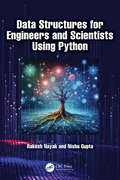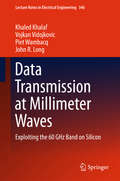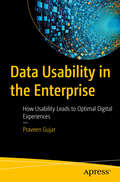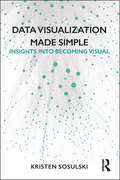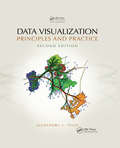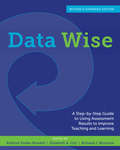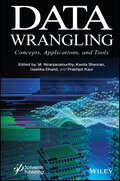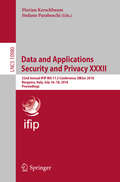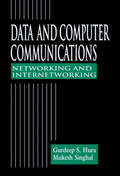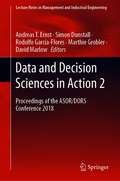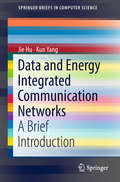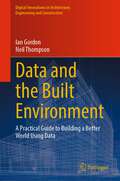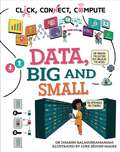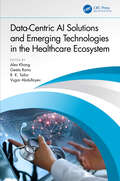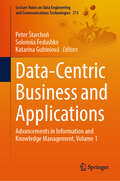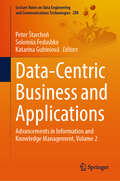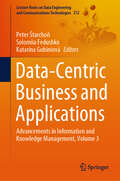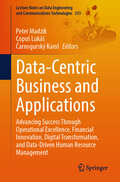- Table View
- List View
Data Storytelling and Visualization with Tableau: A Hands-on Approach
by Parikshit Narendra Mahalle Prachi Manoj JoshiWith the tremendous growth and availability of the data, this book covers understanding the data, while telling a story with visualization including basic concepts about the data, the relationship and the visualizations. All the technical details that include installation and building the different visualizations are explained in a clear and systematic way. Various aspects pertaining to storytelling and visualization are explained in the book through Tableau. Features Provides a hands-on approach in Tableau in a simplified manner with steps Discusses the broad background of data and its fundamentals, from the Internet of Everything to analytics Emphasizes the use of context in delivering the stories Presents case studies with the building of a dashboard Presents application areas and case studies with identification of the impactful visualization This book will be helpful for professionals, graduate students and senior undergraduate students in Manufacturing Engineering, Civil and Mechanical Engineering, Data Analytics and Data Visualization.
Data Structures for Engineers and Scientists Using Python
by Nishu Gupta Rakesh NayakThe text covers the fundamentals of Python programming and the implementation of data structures using Python programming with the help of worked-out examples. It provides a learning tool for engineers as well as for researchers and scientists of advanced level. The text further discusses important concepts such as polynomial manipulation, sparse matrices, implementation of stack using the queue model and topological sorting.This book: Discusses the implementation of various data structures such as an array, stack, queue, tree and graph along with sorting and searching algorithms. Includes programming tips to highlight important concepts and help readers avoid common programming errors. Presents each concept of data structure with a different approach and implements the same using Python programming. Offers rich chapter-end pedagogy including objective-type questions (with answers), review questions and programming exercises to facilitate review. Covers fundamentals of Python up to object-oriented concepts including regular expression. It is primarily written for senior undergraduate, graduate students and academic researchers in the fields of electrical engineering, electronics and communication engineering, computer engineering and information technology.
Data Technology in Materials Modelling (SpringerBriefs in Applied Sciences and Technology)
by Martin Thomas Horsch Silvia Chiacchiera Welchy Leite Cavalcanti Björn SchemberaThis open access book discusses advances in semantic interoperability for materials modelling, aiming at integrating data obtained from different methods and sources into common frameworks, and facilitating the development of platforms where simulation services in computational molecular engineering can be provided as well as coupled and linked to each other in a standardized and reliable way. The Virtual Materials Marketplace (VIMMP), which is open to all service providers and clients, provides a framework for offering and accessing such services, assisting the uptake of novel modelling and simulation approaches by SMEs, consultants, and industrial R&D end users. Semantic assets presented include the EngMeta metadata schema for research data infrastructures in simulation-based engineering and the collection of ontologies from VIMMP, including the ontology for simulation, modelling, and optimization (OSMO) and the VIMMP software ontology (VISO).
Data Transmission at Millimeter Waves: Exploiting the 60 GHz Band on Silicon (Lecture Notes in Electrical Engineering #346)
by Khaled Khalaf Vojkan Vidojkovic Piet Wambacq John R. LongThis book describes the design of a receiver front-end circuit for operation in the 60GHz range in 90nm CMOS. Physical layout of the test circuit and post-layout simulations for the implementation of a test chip including the QVCO and the first stage divider are also presented. The content of this book is particularly of interest to those working on mm-wave frequency generation and signal reception.
Data Usability in the Enterprise: How Usability Leads to Optimal Digital Experiences
by Praveen GujarEnsuring data usability is paramount to unlocking a company’s full potential and driving informed decision-making. Part of author Saurav Bhattacharya’s trilogy that covers the essential pillars of digital ecosystems—security, reliability, and usability—this book offers a comprehensive exploration of the fundamental concepts, principles, and practices essential for enhancing data accessibility and effectiveness. You’ll study the core aspects of data design, standardization, and interoperability, gaining the knowledge needed to create and maintain high-quality data environments. By examining the tools and technologies that improve data usability, along with best practices for data visualization and user-centric strategies, this book serves as an invaluable resource for professionals seeking to leverage data more effectively. The book also addresses crucial governance issues, ensuring data quality, integrity, and security are maintained. Through a detailed analysis of data governance frameworks and privacy concerns, you’ll see how to manage data responsibly. Additionally, the book includes compelling case studies that highlight successful data usability implementations, future trends, and the challenges faced in achieving optimal data usability. By fostering a culture of data literacy and usability, this book will help you and your organization navigate the evolving data landscape and harness the power of data for innovation and growth. What You Will Learn Understand the fundamental concepts and importance of data usability, including effective data design, enhancing data accessibility, and ensuring data standardization and interoperability. Review the latest tools and technologies that enhance data usability, best practices for data visualization, and strategies for implementing user-centric data approaches. Ensure data quality and integrity, while navigating data privacy and security concerns. Implement robust data governance frameworks to manage data responsibly and effectively. Who This Book Is For Cybersecurity and IT professionals
Data Visualization Made Simple: Insights into Becoming Visual
by Kristen SosulskiData Visualization Made Simple is a practical guide to the fundamentals, strategies, and real-world cases for data visualization, an essential skill required in today’s information-rich world. With foundations rooted in statistics, psychology, and computer science, data visualization offers practitioners in almost every field a coherent way to share findings from original research, big data, learning analytics, and more. In nine appealing chapters, the book: examines the role of data graphics in decision-making, sharing information, sparking discussions, and inspiring future research; scrutinizes data graphics, deliberates on the messages they convey, and looks at options for design visualization; and includes cases and interviews to provide a contemporary view of how data graphics are used by professionals across industries Both novices and seasoned designers in education, business, and other areas can use this book’s effective, linear process to develop data visualization literacy and promote exploratory, inquiry-based approaches to visualization problems.
Data Visualization for People of All Ages (ISSN)
by Nancy OrganData visualization is the art and science of making information visible. On paper and in our imaginations, it’s a language of shapes and colors that holds our best ideas and most important questions. As we find ourselves swimming in data of all kinds, visualization can help us to understand, express, and explore the richness of the world around us. No matter your age or background, this book opens the door to new ways of thinking and sharing through the power of data visualization.Data Visualization for People of All Ages is a field guide to visual literacy, born from the author’s personal experience working with world-class scholars, engineers, and scientists. By walking through the different ways of showing data—including color, angle, position, and length—you’ll learn how charts and graphs truly work so that no visualization is ever a mystery or out of reach. It doesn’t stop at what fits on a page, either. You’ll journey into cutting-edge topics like data sonification and data physicalization, using sound and touch to share data across the different senses. Packed with practical examples and exercises to help you connect the dots, this book will teach you how to create and understand data visualizations on your own—all without writing a single line of code or getting tangled up in software.Written with accessibility in mind, this book invites everyone to the table to share the joy of one of today’s most necessary skills. Perfect for home or classroom use, this friendly companion gives people of all ages everything they need to start visualizing with confidence.
Data Visualization: Principles and Practice, Second Edition
by Alexandru C. TeleaDesigning a complete visualization system involves many subtle decisions. When designing a complex, real-world visualization system, such decisions involve many types of constraints, such as performance, platform (in)dependence, available programming languages and styles, user-interface toolkits, input/output data format constraints, integration wi
Data Wise, Revised and Expanded Edition: A Step-by-Step Guide to Using Assessment Results to Improve Teaching and Learning
by Kathryn Parker BoudettData Wise, Third Edition (9781682539972) is now available! The new edition isn't just an update—it's an equity transformation that makes Data Wise clearer, more inclusive, and applicable beyond K-12 to support whole-child learning. ***Data Wise, Revised and Expanded Edition presents a continuous, sustainable process that allows school leaders to harness classroom metrics to inform educational practice.At its core, the Data Wise method fosters effective collaboration among educators, enabling teams to study a wide range of evidence and then use what they learn to enrich school culture and climate and ensure that each student thrives.Kathryn Parker Boudett, Elizabeth A. City, and Richard J. Murnane offer clear guidance for enacting all stages of the Data Wise improvement process and for integrating data inquiry into long-term institutional practice. They begin with actions that lay the groundwork for collaboration: advancing assessment literacy among contributors, building productive professional learning communities, and identifying targets for change. They continue with advice on evaluating progress and boosting accountability.Throughout the book, the authors recommend practical tools and proven practices, such as the plus/delta protocol and the ACE Habits of Mind (focusing on action, collaboration, and evidence), that help school leaders optimize the quality of meetings, especially those in which educators analyze data. They also provide tips for how to make best use of developments in education and technology, from Common Core State Standards to online collaboration tools.The field-tested strategies of the Data Wise improvement process have been used to great success in schools around the world, showing that careful examination of test scores, classroom data, and other educational evaluations can become a catalyst for important schoolwide conversations and transformations.
Data Wrangling: Concepts, Applications and Tools
by Prabhjot Kaur M. Niranjanamurthy Kavita Sheoran Geetika DhandDATA WRANGLING Written and edited by some of the world’s top experts in the field, this exciting new volume provides state-of-the-art research and latest technological breakthroughs in data wrangling, its theoretical concepts, practical applications, and tools for solving everyday problems. Data wrangling is the process of cleaning and unifying messy and complex data sets for easy access and analysis. This process typically includes manually converting and mapping data from one raw form into another format to allow for more convenient consumption and organization of the data. Data wrangling is increasingly ubiquitous at today’s top firms. Data cleaning focuses on removing inaccurate data from your data set whereas data wrangling focuses on transforming the data’s format, typically by converting “raw” data into another format more suitable for use. Data wrangling is a necessary component of any business. Data wrangling solutions are specifically designed and architected to handle diverse, complex data at any scale, including many applications, such as Datameer, Infogix, Paxata, Talend, Tamr, TMMData, and Trifacta. This book synthesizes the processes of data wrangling into a comprehensive overview, with a strong focus on recent and rapidly evolving agile analytic processes in data-driven enterprises, for businesses and other enterprises to use to find solutions for their everyday problems and practical applications. Whether for the veteran engineer, scientist, or other industry professional, this book is a must have for any library.
Data and AI Driving Smart Cities (Studies in Big Data #128)
by Ursula Eicker Arturo Molina Pedro Ponce Troy McDaniel Therese Peffer Juana Isabel Mendez Garduno Edgard D. Musafiri Mimo Ramanunni Parakkal Menon Kathryn Kaspar Sadam HussainThis book illustrates how the advanced technology developed for smart cities requires increasing interaction with citizens to motivate and incentive them. Megacities' needs have been encouraging for the creation of smart cities in which the needs of inhabitants are collected using virtualization and digitalization systems. On the other hand, machine learning algorithms have been implemented to provide better solutions for diverse areas in smart cities, such as transportation and health. Besides, conventional electric grids have transformed into smart grids, improving energy quality. Gamification, serious games, machine learning, dynamic interfaces, and social networks are some elements integrated holistically to provide novel solutions to design and develop smart cities. Also, this book presents in a friendly way the concept of social devices that are incorporated into smart homes and buildings. This book is used to understand and design smart cities where citizens are strongly interconnected so the demand response time can be reduced.
Data and Applications Security and Privacy XXXII: 32nd Annual IFIP WG 11.3 Conference, DBSec 2018, Bergamo, Italy, July 16–18, 2018, Proceedings (Lecture Notes in Computer Science #10980)
by Florian Kerschbaum Stefano ParaboschiThis book constitutes the refereed proceedings of the 32nd Annual IFIP WG 11.3 International Working Conference on Data and Applications Security and Privacy, DBSec 2018, held in Bergamo, Italy, in July 2018. The 16 full papers and 5 short papers presented were carefully reviewed and selected from 50 submissions. The papers present high-quality original research from academia, industry, and government on theoretical and practical aspects of information security. They are organized in topical sections on administration, access control policies, privacy-preserving access and computation, integrity and user interaction, security analysis and private evaluation, fixing vulnerabilities, and networked systems.
Data and Computer Communications: Networking and Internetworking
by Gurdeep S. Hura Mukesh SinghalThe protocols and standards for networking are numerous and complex. Multivendor internetworking, crucial to present day users, requires a grasp of these protocols and standards. Data and Computer Communications: Networking and Internetworking, a comprehensive text/reference, brings clarity to all of the complex issues involved in networking activi
Data and Decision Sciences in Action 2: Proceedings of the ASOR/DORS Conference 2018 (Lecture Notes in Management and Industrial Engineering)
by Simon Dunstall Andreas T. Ernst Rodolfo García-Flores Marthie Grobler David MarlowThis book constitutes the proceedings of the Joint 2018 National Conferences of the Australian Society for Operations Research (ASOR) and the Defence Operations Research Symposium (DORS). Offering a fascinating insight into the state of the art in Australian operations research, this book is of great interest to academics and other professional researchers working in operations research and analytics, as well as practitioners addressing strategic planning, operations management, and other data-driven decision-making challenges in the domains of commerce, industry, defence, the environment, humanitarianism, and agriculture. The book comprises 21 papers on topics ranging from methodological advances to case studies, and addresses application domains including supply chains, government services, defence, cybersecurity, healthcare, mining and material processing, agriculture, natural hazards, telecommunications and transportation.ASOR is the premier professional organization for Australian academics and practitioners working in optimization and other disciplines related to operations research. The conference was held in Melbourne, Australia, in December 2018.
Data and Energy Integrated Communication Networks: A Brief Introduction (SpringerBriefs in Computer Science)
by Kun Yang Jie HuThe book discusses data and energy integrated communication networking technologies, including the latest research contributions in this promising area. It firstly provides an overview of data and energy integrated communication networks (DEINs) and introduces the key techniques for enabling integrated wireless energy transfer (WET) and wireless information transfer (WIT) in the radio frequency (RF) band. It then describes the ubiquitous architecture of DEINs and demonstrates the typical DEIN system and investigates the core issues in both the physical layer and the medium-access-control (MAC) layer in order to coordinate both the WIT and WET in the same RF band. Lastly, the book addresses a number of emerging research topics in the field of DEINs. It promotes joint efforts from both academia and industry to push DEIN a step closer to practical implementation. It is also a valuable resource for students interested in studying cutting-edge techniques in this field.
Data and Goliath: The Hidden Battles to Collect Your Data and Control Your World
by Bruce SchneierYou are under surveillance right now.<P><P> Your cell phone provider tracks your location and knows who’s with you. Your online and in-store purchasing patterns are recorded, and reveal if you're unemployed, sick, or pregnant. Your e-mails and texts expose your intimate and casual friends. Google knows what you’re thinking because it saves your private searches. Facebook can determine your sexual orientation without you ever mentioning it.<P> The powers that surveil us do more than simply store this information. Corporations use surveillance to manipulate not only the news articles and advertisements we each see, but also the prices we’re offered. Governments use surveillance to discriminate, censor, chill free speech, and put people in danger worldwide. And both sides share this information with each other or, even worse, lose it to cybercriminals in huge data breaches.<P> Much of this is voluntary: we cooperate with corporate surveillance because it promises us convenience, and we submit to government surveillance because it promises us protection. The result is a mass surveillance society of our own making. But have we given up more than we’ve gained? In Data and Goliath, security expert Bruce Schneier offers another path, one that values both security and privacy. He shows us exactly what we can do to reform our government surveillance programs and shake up surveillance-based business models, while also providing tips for you to protect your privacy every day. You'll never look at your phone, your computer, your credit cards, or even your car in the same way again.
Data and the Built Environment: A Practical Guide to Building a Better World Using Data (Digital Innovations in Architecture, Engineering and Construction)
by Neil Thompson Ian GordonThis book takes a data-first approach to framing the built environment sector’s unique challenges and how industry can address them through better use of data. It describes how the sector has failed to derive value from data, and the common causes underlying this failure. It then provides practical guidance on how to use data to construct and operate built environment assets in a manner that better meets society’s needs. The book examines how industry norms, organizational culture, and our personal behaviours contribute to the successful use of data. It sets out a philosophy and vision for the use of data in the built environment, and how this in turn might help the sector realise better outcomes in terms of cost, schedule, quality, and sustainability. Data is a valuable asset, one that the built environment sector must generate, protect, manage, and exploit. The book works as a holistic primer to data and the built environment, written both for those who are new to data or the built environment, and including deep-dive material that will provide insight to experienced professionals.
Data, Big and Small (Click, Connect, Compute #3)
by Dharini BalasubramaniamData science fundamentals, using clear, expert explanations and comic illustrations to spark interest and enthusiasm in the next generation of computer scientists!Data, Big and Small delves into the details behind computer science data and information, which help people and organisations to make decisions. Learn how and why data are created, stored and shared. Find out how we make sense of information through graphs, maps and pictures, and understand how machines learn from the data that we feed them. The end of the book fast-forwards to the future of computer science, data and robotics, and considers what it might mean to live in a 'smarter' world.Contents: What are data? / Data, information and knowledge / Data are vital / Where do data come from? / Getting the format right / Storing all those data / The value is in the processing / Picture it! / Big data / Getting the most out of data / Keeping data secure / A trip into the future of data ... / Pioneer portraits / Further information / Glossary / Quiz yourself! / IndexThe Click, Connect, Compute series untangles the computer science web and teaches children about the essentials of computer software, hardware and digital literacy as well as discussing the ethics surrounding this evolving field. Featuring fun, friendly comic strip illustrations, pioneer bios and a quiz, this is a perfect read for children aged 8+.Books in the series: Computer Science Essentials / Data, Big and Small / Smart Machines / The Languages of ProgrammingWritten in a clear, thoughtful way by computer science expert, Dr. Dharini Balasubramaniam, a strong advocate for ethics and education in her field.
Data, Security, and Trust in Smart Cities (Signals and Communication Technology)
by Stan McClellanThis book provides a comprehensive perspective on issues related to the trustworthiness of information in the emerging “Smart City.” Interrelated topics associated with the veracity of information are presented and discussed by authors with authoritative perspectives from multiple fields. The focus on security, veracity, and trustworthiness of information, data, societal structure and related topics in connected cities is timely, important, and uniquely presented. The authors cover issues related to the proliferation of disinformation and the mechanics of trust in modern society. Topical issues include trust in technologies, such as the use of machine learning (ML) and artificial intelligence (AI), the importance of encryption and cybersecurity, and the value of protecting of critical infrastructure. Structural issues include legal and governmental institutions, including the basis and importance of these fundamental components of society. Functional issues also include issues of societal trust related to healthcare, medical practitioners, and the dependence on reliability of scientific results. Insightful background on the development of AI is provided, and the use of this compelling technology in applications spanning networks, supply chains, and business practices are discussed by practitioners with direct knowledge and convincing perspective. These thought-provoking opinions from notable industry, academia, medicine, law, and government leaders provide substantial benefit for a variety of stakeholders.
Data-Centric AI Solutions and Emerging Technologies in the Healthcare Ecosystem
by Geeta Rana Alex Khang Vugar Abdullayev R. K. TailorThe book offers insight into the healthcare system by exploring emerging technologies and AI-based applications and implementation strategies. It includes current developments for future directions as well as covering the concept of the healthcare system along with its ecosystem. Data-Centric AI Solutions and Emerging Technologies in the Healthcare Ecosystem focuses on the mechanisms of proposing and incorporating solutions along with architectural concepts, design principles, smart solutions, decision-making process, and intelligent predictions. It offers state-of-the-art approaches for overall innovations, developments, and implementation of the smart healthcare ecosystem and highlights medical signal and image processing algorithms, healthcare-based computer vision systems, and discusses explainable AI (XAI) techniques for healthcare. This book will be useful to researchers involved in AI, IoT, Data, and emerging technologies in the medical industry. It is also suitable as supporting material for undergraduate and graduate-level courses in related engineering disciplines.
Data-Centric Business and Applications: Advancements in Information and Knowledge Management, Volume 1 (Lecture Notes on Data Engineering and Communications Technologies #213)
by Solomiia Fedushko Peter Štarchoň Katarína GubíniováThis book explores the profound impact of data on company operations, decision-making, and application development. The book delves into sophisticated information and knowledge management principles, including data governance, analytics, knowledge discovery, and artificial intelligence. The subject encompasses data-centric business models, emerging technology, and ethical considerations. Each chapter is authored by an expert in the area who offers important insights into the influence of data on the advancement of business and application development. The material herein is appropriate for a diverse audience, encompassing academics, practitioners, business professionals, and researchers. The editors sincerely appreciate the writers for their significant contributions, which have been crucial in developing an essential resource for studying and advancing data-centric businesses and applications.
Data-Centric Business and Applications: Advancements in Information and Knowledge Management, Volume 2 (Lecture Notes on Data Engineering and Communications Technologies #208)
by Solomiia Fedushko Peter Štarchoň Katarína GubíniováThis book stands out by exploring the significance of data in various aspects of business, including operations, decision-making, and application development, in a comprehensive and accessible manner. It delves into advanced topics such as data management, analytics, knowledge discovery, artificial intelligence, data-centric business models, emerging technologies, and ethical implications, providing a unique perspective. The book is appropriate for academics, professionals, and researchers with intermediate to advanced data management skills. Data plays a crucial role in today's rapidly evolving digital environment, serving as the foundation for businesses and the key element in driving innovation across diverse industries. This book delves into the latest advancements in data management, their impact on modern corporate settings, and advanced information and knowledge management concepts. The chapters in this book discuss various topics, including incorporating data-driven methods into business models, the difficulties and advantages of emerging technology, and the ethical aspects of making decisions based on data.
Data-Centric Business and Applications: Advancements in Information and Knowledge Management, Volume 3 (Lecture Notes on Data Engineering and Communications Technologies #212)
by Solomiia Fedushko Peter Štarchoň Katarína GubíniováEmbark on a journey into the future of business with a groundbreaking book that explores the dynamic interplay between data and business, unlocking its transformative power in strategy, decision-making, and application development. Dive deep into cutting-edge topics such as data governance, analytics, knowledge discovery, and AI, and gain an in-depth understanding of managing, analyzing, and extracting insights from complex data sets. This book's holistic approach sets this book apart, seamlessly integrating the latest information and knowledge management concepts. From integrating data-centric approaches into business models to addressing considerations in data-driven decisions, the diverse topics covered will provide invaluable insights into the central role of data in shaping the future of business and applications. This book sheds light on the ongoing advances in structural management, demonstrating how previously understood knowledge, technologies, and data can pave the way for sustainable solutions in the face of innovation, meet insight, and allow businesses to thrive in the digital age.
Data-Centric Business and Applications: Advancing Success Through Operational Excellence, Financial Innovation, Digital Transformation, and Data-Driven Human Resource Management (Lecture Notes on Data Engineering and Communications Technologies #253)
by Peter Madzík Copuš Lukáš Čarnogurský KarolThis book provides a comprehensive insight into contemporary management challenges shaped by digital transformation, operational excellence, and data-driven human resource strategies. It presents innovative frameworks for decision-making, workforce optimization, and financial innovation by integrating theoretical perspectives with real-world applications. With contributions from international scholars, it offers fresh perspectives on emerging technologies, sustainability, and business intelligence. Designed for academics, professionals, and policymakers, the book serves as a valuable resource for understanding and implementing effective management strategies in the digital era.
Data-Centric Business and Applications: Evolvements in Business Information Processing and Management (Volume 3) (Lecture Notes on Data Engineering and Communications Technologies #42)
by Natalia Kryvinska Dmytro Ageyev Tamara RadivilovaBuilding on the authors’ previous work, this book addresses key processes and procedures used in information/data processing and management. Modern methods of business information processing, which draw on artificial intelligence, big data, and cloud-based storage and processing, are opening exciting new opportunities for doing business on the basis of information technologies. Thus, in this third book, the authors continue to explore various aspects – technological as well as business and social – of the information industries. Further, they analyze the challenges and opportunities entailed by these kinds of business.

